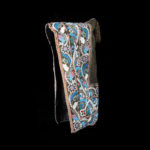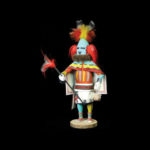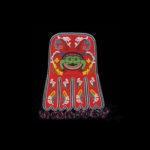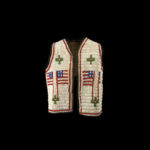The objects featured in this exhibit, ones seen publicly for the first time, are drawn from a private collection developed over the past 30 years by an adventuresome couple from Tennessee.
What started as a simple memento of the Southwest—a pair of small kachina dolls purchased in Santa Fe, New Mexico—eventually led to a remarkably rich and diverse collection of items produced by Indian peoples throughout all culture areas of Native North America.
With each new specimen, the couple wanted to learn more about not only the object itself but also the cultural context within which it was made and used. Each new item added momentum to the couple’s quest to expand and diversify their holdings. They were increasingly drawn to the scholarly literature on Indian art; they visited museums and Indian reservations across the United States and Canada; and they initiated contact with well-known dealers from coast to coast. They also began tailoring their vacations to match their collecting interests concerning the work of particular Indian artists, artifact types, and culture areas. All of this activity was fueled by the desire to broaden their understanding of the material culture of Native Americans. Their history of collecting can best be characterized as a journey of discovery, one they hope the viewer will share while touring this exhibit.
- Cree Woman’s Bonnet, Height: 20 in.
- Hopi Kachina Doll, Height: 20 in.
- Inuit (Eskimo) Ivory Carving, Length: 12 in.
- Tlingit Octopus Bag, Height: 24 in.
- Lakota Boy’s Vest, Height: 18 in.
The choices were guided by artifact type, quality, and tribal—as well as regional—representation. Each item holds artistic and cultural merit of its own; collectively, though, the specimens hold great value for three key reasons:
- First, they convey the broad range or diversity of American Indian material culture.
- Second, they say volumes about the creativity and resilience of Indian peoples and how they not only incorporated aspects of Euro-American culture but also employed art as an expression of ethnic identity, solidarity, and pride.
- Third, members of the general public and the academic community are given an opportunity to further pursue their interests in American Indian peoples and the richness of their applied arts.
Concerning the age of the specimens, they span at least 150 years. While some of the pieces, particularly those from the Northwest Coast, are the work of well-known contemporary Indian artists, most of the items within this exhibit date to the closing decades of the nineteenth century. The personal identity of the artists who crafted these objects or those who once owned them is not, in most cases, known. For this reason we have chosen a number of historic photographs that show Indian peoples of the past wearing or making items similar to those placed on display. In doing so we have tried to bring a human context to what viewers see as they view the exhibit.
It should also be noted here that most of the objects were made for Indian use—frequently by family members, extended kin, and others within the artist’s own tribe. However, some items were made expressly for sale to whites. This was particularly true for the Iroquois of New York and Canada, who produced a wealth of relatively small beaded items—coin purses, handbags, pincushions, wall plaques, slippers, and caps—that were purchased by tourists who visited Niagara Falls during the late 1800s and early 1900s. Curio art emerged in other locales as well, particularly in the American Southwest. This tradition has grown significantly over the past several decades. For many Indian peoples throughout the United States and Canada, art now represents a major source of income. This was certainly not the case for most tribes in the past.
Collectively the specimens within this exhibit represent a wide range of cultural uses. Some were strictly utilitarian, such as baskets crafted for collecting, transporting, and storing wild plant foods. Other items were made for use in restricted ritual or ceremonial contexts. The elaborately carved and painted wooden masks of the indigenous peoples of the Arctic and Northwest Coast are a clear case in point. Some pieces, for example, the pipe bags of the Plains Indians, served both utilitarian and religious roles. They were intimately connected to the sacred pipe, as well as to tobacco, a sacred plant.
Many of the specimens pertain to personal attire and adornment. Yet here their function goes far beyond mere clothing or appearance. These items signaled ethnic or tribal identity, status, personal achievements, gender, and the consummate artistic skills of the women who produced and embellished them. This was certainly the case for the beautifully beaded bandolier bags of the Ojibwa and other groups in the western Great Lakes region. Even clothing made for children went beyond the extent of personal attire. The items publicly conveyed a mother’s skill, generosity, and love for the child who received them. Moreover, clothing was an effective way of socializing children and instilling in them a sense of pride in their tribal identity.
Women made many of the specimens in this exhibit, including the baskets, weavings, and most of the beadwork. Though the production of weapons and hunting tools, and the carving of wood, ivory, stone, and metal fell into the domain of male-produced art, a large component of Native American art is women’s art. It should also be recalled that Indians of the past never created art simply for the sake of artistic expression. Rather, material items that were artistically treated always held functional roles beyond the purely aesthetic.
Well over thirty tribal groups are represented by the pieces contained in this exhibit. Each of the ten culture areas of Native North America is also represented by these beautiful items. As is often the case, this private collection of Indian art is particularly strong in certain areas and artifact types and relatively thin in others. This is simply the result of the collecting interests of the couple who graciously placed these items on loan to the McClung Museum. All who view this exhibit will quickly come to appreciate the primary strengths of this remarkable collection: carved masks from the Arctic and Pacific Northwest Coast, and beadwork from the Great Lakes, the Northeastern Woodlands, and the Canadian Subarctic. Items made and used by Indians residing elsewhere—in the Plateau, the Great Basin, California, the American Southwest, the Great Plains, and the Southeastern Woodlands—are also featured in this exhibit. The depth of their presence, as noted above, does not match what is seen for tribal groups in the north. They serve well, however, to give viewers a sense of the immense range of diversity within the domain of American Indian art.
A number of themes are addressed and visually illustrated through this exhibit. Of overriding importance is the theme of diversity. This holds for artifact type, as well as for the raw materials—both natural and manufactured—used by Indian artists in the production and decorative embellishment of material culture.
A related theme concerns what scholars call “indigenization.” This is the process whereby Native peoples borrow objects or ideas from Euro-American culture and decorate them in a manner consistent with their own aesthetic standards or traditions. Classic examples of this are the beautiful Midewiwin bags of the Ojibwa, Winnebago, and other tribes of the western Great Lakes. These large beaded shoulder bags were worn by healers and they also served as a highly visible sign of status for the men who owned them and the women who made them. Nonetheless, they were copied after the much smaller plain leather shot bags of white frontiersmen. Vests, gloves, tailored jackets, shirts, and dresses are other well-known examples. Indian peoples of the past, as well as those today, have borrowed freely from whites, but almost always on their own terms. Other themes deal with such related topics as long-distance trade, beadwork, and functional roles of art.
A special thanks to exhibit curators, Michael H. Logan and Gerald F. Schroedl of the UT Department of Anthropology, and to the anonymous lenders who shared a portion of their collection. Original Curtis prints courtesy of Special Collections, UT Library.





